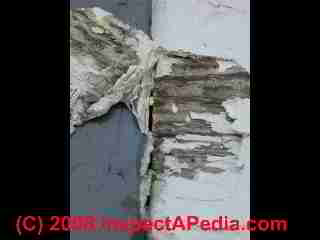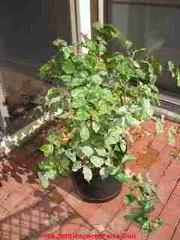 Differences Between Mildew & Mold
Differences Between Mildew & Mold
Products labeled "mildewcide" & reports of "mildew" in buildings?
- POST a QUESTION or COMMENT about mildew reported in buildings and found on plants.
What's the difference between mold & mildew? This article explains the difference between mildew and mold (or other forms of mold).
As we discuss in this article, mildew, a sub-class of molds, is an obligate parasite that grows only on living plants, and is generally white in appearance.
Our page top photograph shows mildew growing on a jasmine plant at a Vassar College home in Poughkeepsie, New York. More photographs of mildew are included in this article.
InspectAPedia tolerates no conflicts of interest. We have no relationship with advertisers, products, or services discussed at this website.
What's the Difference between "Mold" and "Mildew"?
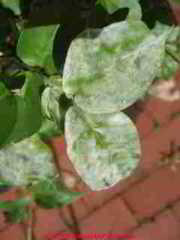
Our closeup photographs above show powdery mildew growing on the leaves of a jasmine plant. Mildew is a specific type of mold that grows on living plants. Just on plants. Notice that this mold (mildew) is white? Mildew is always white or perhaps light gray in color.
Article Contents
- MILDEW PHOTOGRAPHS BUILDINGS
- WHAT DOES MILDEW LOOK LIKE? - white stuff on plants
- MILDEWS - TWO KINDS two sub-groups, with quite a few sub-species
- POWDERY MILDEW
- DOWNY MILDEW
- DOES MILDEW GROW ON or IN BUILDINGS? - nope - not unless your building is made of live grape leaves
- DOES IT MATTER WHAT WE CALL IT? Whether We Call Mold Found on or in a Building Mildew or Mold? Well yeah.
What Does Mildew Look Like
Though both of these groups may also include other species, they all look similar on plants - white or gray powdery or splotchy deposits on plant leaves and stems. You will see white mildew on green leaves of our Jasmine plant in two photos here.
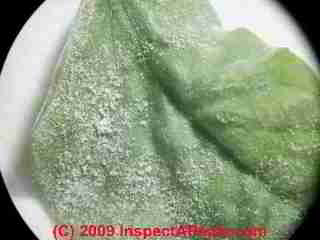 Mildew may appear on the plant's buds, flowers, fruits, in sum, just about on any live plant tissue, though not so likely on heavy dry bark such as on tree bark or on woody stems.
Mildew may appear on the plant's buds, flowers, fruits, in sum, just about on any live plant tissue, though not so likely on heavy dry bark such as on tree bark or on woody stems.
Above: Powdery Mildew growing on the Jasmine plant on our patio. Below is a microscopic examine of just one spore produced by this mildew colony.
Our lab microphotograph given below shows the hyaline (colorless) spores of Oidium-Erysiphe that we collected from the jasmine plant shown in the photographs in this article. In the microscope, mildew spores (Oidium-Erysiphe) are colorless; on a plant this mold species appears as a white powdery substance.
In sum, mildew is a white powdery fungus that is an obligate parasite found on living plants.
For people worried about mold on indoor surfaces: drywall, shoes, or old wet cardboard boxes, if you see stuff growing on those materials it's mold, but it's not mildew.
Below in this article we provide an example PHOTO of An Indoor Mold Contamination - that is Not Mildew and
at MOLD APPEARANCE on VARIOUS SURFACES you will find a catalog of photos of what mold, real mold, looks like on just about any material in or on buildings (except living plants).
Mildews are divided into two sub-groups, with quite a few sub-species
Mildew: in general terms, Mildew is a proper subset of the broader mold family. It is a living-plant parasite. Mildew grows only on living plants.
Among the major groups of molds is a very large mold family, Basidiomycota (or basidiomycetes); this family in turn includes, among the many Basidiomycota members, we find a relatively small sub-group, the Ustilaginales, also familiarly called Smuts and Mildews.
- Oidium-Erysiphe, familiarly named Powdery Mildew, and
- Peronosporaceae, familiarly named Downy Mildew
To be just slightly more technically correct, though any introductory class in mycology may lump Downy and Powdery people together, Beckman points out that
[Downy mildews ] on the other hand, are a completely different kingdom of organisms [than their powdery lookalike friends], more closely related to algae than to fungi.
Is it important to make the distinction between powdery and downy mildew? You bet!
There are important differences in these two groups of plant pathogens in what plants they attack and in how they can be controlled. What works for one class won't work for the other.
Powdery Mildew: Oidium-Erysiphe
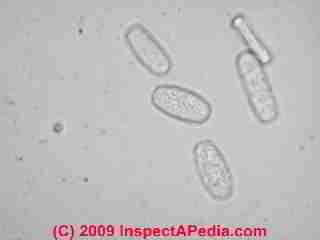 Both smuts and mildews are parasites of living plants (in mycological terms these are obligate biotrophic pathogens) that cause serious crop damage as well as damage to ornamental shrubs, flowers, etc.
Both smuts and mildews are parasites of living plants (in mycological terms these are obligate biotrophic pathogens) that cause serious crop damage as well as damage to ornamental shrubs, flowers, etc.
See Kiss et als. for an example of mildew damage to tomatoes.
Above: a lab photo of mildew spores collected from the jasmine plant at page top. This is Oidium-Erysiphe or Powdery Mildew
To understand our comment that mildew does not grow in or on buildings, notice our use of the words obligate biotrophic pathogens - meaning that these fungi are pathogens that grow only on living plants and that they cause a disease in the plant.
Powdery Mildew Reference
- Downer, Jim, POWDERY and DOWNY MILDEWS [PDF] University of California, DIv. Agriculture & Natural Resource, UC Nursery and Floriculture Alliance, retrieved 2019/11/08, original source: http://ucnfanews.ucanr.edu/Articles/Disease_Focus/Powdery_and_Downy_Mildews/
Excerpts: Powdery mildews are plant pathogens attacking over 10,000 species of plants and belonging to more than 1600 genera of fungi in the class Ascomycetes. ...Powdery mildews are controlled by a broad range of prophylactic and systemic fungicides. . - Gillman, Dan, POWDERY MILDEW [PDF] (2011) U. Mass Extension, Amherst, retrieved 2019/11/08 original source: https://ag.umass.edu/landscape/fact-sheets/powdery-mildew
- Kiss, Levante et als, "Identification of two powdery mildew fungi, Oidium neolycopersici sp. nov. and O. lycopersici, infecting tomato in different parts of the world",
Levente KISS, Roger T. A. COOK, Gregory S. SAENZ, James H. CUNNINGTON, Susumu TAKAMATSU, Ian PASCOE, Marc BARDIN, Philippe C. NICOT, Y. SATO and Amy Y. ROSSMAN, Mycological Research (2001), 105:6:684-697 Cambridge University Press, The British Mycological Society 2001 provides an example of the problem of mildew damage to crops, from which we quote the abstract:
A world-wide study of the Oidium species causing economic damage on tomato has identified two taxa using classical morphological, scanning electron microscope (SEM) and molecular phylogenetic analyses. The material consisted of a total of 25 tomato powdery mildew isolates and 29 herbarium specimens coming from all continents where tomatoes are grown. A taxon with non-catenate conidia widespread in Europe, Africa, North and South America and Asia was identified as an O. subgen. Pseudoidium species (teleomorph: Erysiphe sect. Erysiphe).
Formerly mistaken for O. lycopersicum (or O. lycopersici), it is now recognised as a distinct species, O. neolycopersici sp. nov. A phylogenetic analysis of the internal transcribed spacer (ITS) sequences of the ribosomal DNA (rDNA) indicated that O. neolycopersici is closely related to Erysiphe macleayae, E. aquilegiae and other Pseudoidium species.
Only a taxon with catenate conidia was found on Australian specimens. This was identified as a species of O. subgen. Reticuloidium (teleomorph: Golovinomyces sp.). Phylogenetic analysis of the rDNA ITS sequences showed that this species is closely related to O. longipes infecting eggplant. Because it is most likely to be the same species as the original O. lycopersicum, which was actually first described in Australia, this is here neotypified as O. lycopersici. - Scheck H, Chitambar J, Dara SK. 2016. Reporting downy mildew of ice plants in California. Pest News. http://ucanr.edu/blogs/blogcore/postdetail.cfm?postnum=20558.
- USDA, "Greenhouse Flower Crop Disease Prevention," USDA, originally from the Cornell University Extension, see www.reeis.usda.gov/web/crisprojectpages/209797.html Abstract is quoted in part just below:
Greenhouse flower growers are annually faced with the need to manage new diseases caused by powdery mildews and downy mildews that disfigure crops and make them unsaleable. Information is not available to help them determine the source of the epidemics, to control the environment so it is not conducive to disease, to identify less-susceptible crops, or to use the most environmentally responsible chemical protectants. - BC Agriculture Ministryt, "Management of Powdery Mildew, Leveillula taurica, in Greenhouse Peppers," Ministry of Agriculture and Lands, British Columbia - Original source: www.agf.gov.bc.ca/cropprot/peppermildew.htm Below we provide a partial quote from the introduction to this excellent document:
Powdery mildew, Leveillula taurica, became a new and serious threat to British Columbia’s greenhouse bell pepper industry early February, 2003. The disease was found simultaneously in two separate locations near Langley in southern British Columbia. Trace amounts of mildew developed on the foliage of cultivar Zamboni in one operation and 10-80% of the foliage of cultivar Triple Four in an organic operation. Reported pepper fruit yield losses have been 2 to 4 kg/m2. By summer, pepper powdery mildew was reported throughout British Columbia’s pepper greenhouses.
Dutch research has shown a direct relationship between per cent mildew infection of the leaves and yield loss. One per cent mildew infection on the leaves results in a one percent yield loss. Studies show that the higher the level of powdery mildew infection the higher the loss of production. An early, heavy infection with mildew had about 30% loss of production compared to a later, lighter infection. Powdery mildew generally has caused 10-15% yield loss in NA greenhouse pepper crops. Greenhouse pepper growers need to follow an intensive disease prevention plan because it is very important that powdery mildew never gets out of hand.
Once pepper leaves are infected with powdery mildew it is difficult to control; if left unchecked the crop can be entirely destroyed. Monitor the crop right from the start. Apply preventive fungicide sprays once the disease is detected. Carry out strict hygiene throughout the year and practice a thorough year-end clean up. There are no powdery mildew resistant pepper varieties currently available.
Downy Mildew: Peronospora
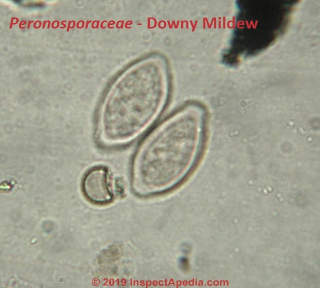 Photo: Peronospora or Peronosporaceae Downy Mildew - actually this photo is old so I'm not sure from what or how this Downy mildew sample spore was collected.
Photo: Peronospora or Peronosporaceae Downy Mildew - actually this photo is old so I'm not sure from what or how this Downy mildew sample spore was collected.
Downy Mildew Reference
- Beckman, Janna, DISEASES of LANDSCAPE PLANTS: DOWNY MILDEW [PDF] Purdue University Extension, Dept. of Botany and Plant Pathology, retrived 2019/11/08 original source: https://www.extension.purdue.edu/extmedia/BP/BP-68-W.pdf
This is helpful in showing downy mildewon ornamentalssuch as roses. Beckerman makes this important distinction:
Downy mildews are a group of closely related pathogens that can cause major damage in the nursery, greenhouse, and landscape in the form of leaf spots, blights, and distortions. ...
Although similar in name, do not confuse downy mildews with powdery mildews.
Powdery mildews are true fungal pathogens that produce white, flour-like colonies — usually on upper leaves.
Downy mildews, on the other hand, are a completely different kingdom of organisms, more closely related to algae than to fungi. Downy mildews produce grayish, fuzzy looking spores and mycelium on the lower leaf surfaces.
The distinction between powdery mildews and downy mildews is important, because the fungicides effective against one are not usually effective against the other — although, as with every rule, exceptions do exist. - Kendrick, Bryce, Fifth Kingdom, [book for sale at Amazon] ISBN13: 9781585100224. We recommend the CD-ROM version of this book.
This 3rd/edition is a compact but comprehensive encyclopedia of all things mycological. Every aspect of the fungi, from aflatoxin to zppspores, with an accessible blend of verve and wit. The 24 chapters are filled with up-to-date information of classification, yeast, lichens, spore dispersal, allergies, ecology, genetics, plant pathology, predatory fungi, biological control, mutualistic symbioses with animals and plants, fungi as food, food spoilage and mycotoxins. - Rossman, A.Y. Systematic Mycology and Microbiology
Laboratory, ARS, USDA. 14 December 2004. Invasive
Fungi. Peronospora radii — Downy mildew of marguerite
daisy. Retrieved April 8, 2008, from http://nt.ars-grin.gov/
sbmlweb/fungi/index.cfm.
Here is a Photo of An Indoor Mold Contamination - that is Not Mildew
 Mold: In general, mold is a term encompassing a very wide family of organisms (the Fifth Kingdom) that includes more than a million and a half species.
Mold: In general, mold is a term encompassing a very wide family of organisms (the Fifth Kingdom) that includes more than a million and a half species.
Lots of molds grow on lots of different organic substances, under a variety of conditions of light and temperature, but all molds require moisture and something organic on which to grow (paper, wood, paint, cloth, leather, plastic, etc.).
Building mold contamination: although a very large number of molds may grow on various building surfaces and building contents, there are about 200 "bad boys" of mold commonly found contaminating buildings. None of these include the mildews.
See MOLD FREQUENCY in BUILDINGS for a table of the most common molds found in buildings, and
also see MOLD ATLAS & PARTICLES INDEX.
Our photograph (left) shows black, brown, and gray mold growing on drywall in a basement that was flooded. This is mold, but it is not mildew. Different mold genera/species might be growing on the wood framing or insulation materials inside this moldy wall.
There are mold genera or species that can grow on a remarkably wide range of organic materials that are found both outdoors and inside, and that can appear in an wide range of colors (black, brown, red, green, gray, white, orange, tan, yellow, for example) and textures.
Often specific mold genera or species prefer to grow on particular materials, so not all molds grow on all materials. (Most molds will not grow in mold culture media, for example.)
Some molds even grow on top of (and eat) other molds - parasitic molds. Molds are capable of breaking down cellulose, for which we should be thankful. Even though we don't like to find mold breaking down paper covered drywall (paper is made of cellulose), if we didn't have a mold kingdom on earth, we'd all be buried in tons of un-decayed dead plant matter.
Does Mildew Grow on or in Buildings?
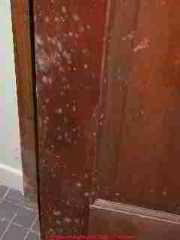 No. Mildew grows on living plants.
No. Mildew grows on living plants.
But lots of people (incorrectly) call various building molds "mildew", and lots of mold cleanup products use the words mildew or mildewcide in their name and instructions.
A mycologist or a good text will tell you what substrates a particular mold has been known to grow on and which types of material it prefers.
For example, mildew is unlikely to be found ever growing on an indoor surface (except for a house plant), since mildew is a pair of sub-group of molds (powdery mildew and downy mildew) which grow only on living plants.
Our photograph of a white mold found growing on an indoor surface (left) is not mildew. It's a mold, but it is not mildew.
So you can see that indoor mold that your home inspector or "mold test expert" has called "mildew"
- might be white but it is not mildew unless it is growing on a plant
- might be other colors than white or gray, which means that it's certainly not mildew
Does it Matter Whether We Call Mold Found on or in a Building Mildew or Mold?
In a practical sense, making the mistake of calling an indoor or outdoor mold found on a building "mildew" is not a big deal. With the exception of avoiding spending on costly cleanup of harmless cosmetic molds or stains, the mold remediation and mold prevention procedures in a building are about the same regardless of mistakes in naming the mold.
You won't find mildew on or in a building on anything but a living plant, despite the names found on indoor or outdoor cleaning products that use the term "mildewcide" and "mildew-resistant product", or found in "mold reports" or in home inspections notwithstanding.
We think that mildew just a less scary name that some folks like to use to describe mold found in buildings, especially in real estate sales. We think that mildew is used on mold cleanup products or mold-resistant products also because of the widespread use of that word by consumers faced with an indoor mold problem.
What Does it Mean if Your Inspector or Mold Expert Calls it Mildew?
See MOLD / ENVIRONMENTAL EXPERT, HIRE ? for help in deciding if you need a mold expert or not. But if your "mold expert" or home inspector tells you that s/he found mildew growing in or on the building, that person may be less of an expert on finding, identifying, and removing problem mold than you hoped, and therefore
- The mold test consultant or mold inspector may not be adequately skilled in finding the most important reservoirs of mold contamination in the building.
If the mold inspector does not understand the basic mycology of what kinds of mold are likely to grow where in a building under what conditions, the inspector is unlikely to know where to look for problem mold and is at risk of reporting superficial mold contamination while completely missing the more serious problem mold reservoir in the structure.
We discuss this problem further at MOLD APPEARANCE - WHAT MOLD LOOKS LIKE,
at MOLD FREQUENCY in BUILDINGS, and
at FIND MOLD in buildings, HOW TO. - If the mold test or mold consultant fails to identify the important mold reservoir in the building, advice given to a building occupant's doctor about building mold exposure may be incorrect.
- The home inspector, mold inspector, or mold remediator's advice on what to do about building mold might also be less than fully accurate.
See MOLD KILLING GUIDE for an example of this problem, and also
see MOLD CLEANUP - MISTAKES to AVOID. - The mold consultant may mistake cosmetic mold for problem mold, spending too much on a mold cleanup of the "wrong problem" in the building.
See MOLD APPEARANCE - STUFF THAT IS NOT MOLD, and Black cosmetic mold.
Atwe discuss more aspects why the difference between mold and mildew matters.
How do I Get Rid of Mildew in my House?
If your "mildew" is found on building surfaces, it is mold, but it is not mildew, and you need to follow normal mold cleanup procedures.
See BASICS YOU NEED to FIND & REMOVE MOLD for a detailed step by step guide to removing problem mold and for identifying and fixing the cause of mold growth in the first place.
If you are having trouble tracking down a moldy smell in your building, try the suggestions we describe
at ODORS GASES SMELLS, DIAGNOSIS & CURE.
If your mildew is indeed growing on a living plant (tomatoes, grapes, crops, house plants, other plants) it can weaken or even kill the plant, at least by interfering with photosynthesis. Mildews on plants may be a species of mildew fungus that is plant specific. For example a mildew that grows on grapes may affect only those plants and may not infect nearby plants of other types, roses for example.
But the conditions that cause powdery mildew to grow on plants invite infection of many plants in a given area. These include crowding (poor air circulation within or around the plant), and dampness or high humidity. If a plant is already stressed or weak from other conditions, it may be more susceptible to mildew infection as well.
While lots of "mildew cleaning" products are sold with the intention of removing mold from building surfaces (bathtub tile grout, for example), do not use such products on plants - you will probably kill the plant.
See MILDEW REMOVAL & PREVENTION for details on what to do about cleaning off or removing mildew, and how to both cure and prevent mildew.
Mold on or In buildings - Molds that are Mistaken for Mildew
See details at MILDEW ERRORS, IT's MOLD
...
Continue reading at MILDEW REMOVAL & PREVENTION or select a topic from the closely-related articles below, or see the complete ARTICLE INDEX.
Or see MILDEW PHOTOGRAPHS FAQs - questions & answers posted originally at this page
Or see these
Recommended Articles
- MILDEW REMOVAL & PREVENTION
- MILDEW on BOOKS?
- MILDEW ERRORS, IT's MOLD
- MILDEW in or on PAINT
- MILDEW PHOTOGRAPHS
- PAPAYA WHITE GROWTH vs DISEASE
- MOISTURE CONTROL in BUILDINGS
- MOLD APPEARANCE on VARIOUS SURFACES
- MOLD APPEARANCE - WHAT MOLD LOOKS LIKE
- MOLD ATLAS & PARTICLES INDEX
- WHITE MOLD PHOTOS
Suggested citation for this web page
MILDEW PHOTOGRAPHS at InspectApedia.com - online encyclopedia of building & environmental inspection, testing, diagnosis, repair, & problem prevention advice.
Or see this
INDEX to RELATED ARTICLES: ARTICLE INDEX to MOLD CONTAMINATION & REMEDIATION
Or use the SEARCH BOX found below to Ask a Question or Search InspectApedia
Ask a Question or Search InspectApedia
Questions & answers or comments about mildew reported in buildings and found on plants.
Try the search box just below, or if you prefer, post a question or comment in the Comments box below and we will respond promptly.
Search the InspectApedia website
Note: appearance of your Comment below may be delayed: if your comment contains an image, photograph, web link, or text that looks to the software as if it might be a web link, your posting will appear after it has been approved by a moderator. Apologies for the delay.
Only one image can be added per comment but you can post as many comments, and therefore images, as you like.
You will not receive a notification when a response to your question has been posted.
Please bookmark this page to make it easy for you to check back for our response.
Our Comment Box is provided by Countable Web Productions countable.ca
Citations & References
In addition to any citations in the article above, a full list is available on request.
- Atlas of Clinical Fungi, 2nd Ed., GS deHoog, J Guarro, J Gene, & MJ Figueras, Centraalbureau voor Schimmelcultures, Universitat Rovira I Virgili, 2000, ISBN 90-70351-43-9
- Mycology, Fundamentals of Diagnostic, Fran Fisher, Norma B. Cook, W.B. Saunders Co. 1998, ISBN 0-7216-5006-6
- Fungi, Identifying Filamentous, A Clinical Laboratory Handbook, Guy St-Germain, Richard Summerbell, Star Publishing, 1996, ISBN 0-89863-177-7 (English)
- "Disease Prevention Program for Certain Vegetable Crops," David B. Langston, Jr., Extension Plant Pathologist - Vegetables, University of Georgia (PDF document) original source: www.reeis.usda.gov/web/crisprojectpages/209797.html
- Disease Prevention in Home Vegetable Gardens [PDF], Patricia Donald,Department of Plant Microbiology and Pathology, Lewis Jett
Department of Horticulture, University of Missouri Extension - extension.missouri.edu/publications/DisplayPub.aspx?P=G6202 - First report of powdery mildew of greenhouse pepper caused by Leveillula taurica in British Columbia, Canada. Cerkauskas, R.F. and A. Buonassisi. Plant Disease 87: 1151. 2003.
- First report of powdery mildew of greenhouse pepper caused by Leveillula taurica in Canada. Cerkauskas, R.F. and J. Brown. Plant Disease 83:781. 1999.
- Suppression of powdery mildew on greenhouse-grown cucumber by addition of silicon to hydroponic nutrient solution is inhibited at high temperature. Schuerger, Andrew and W. Hammer. Plant Disease 87:177-185. 2003.
- Thanks to reader Debra H. for discussing this topic and whose questions suggested this clarifying article 11/28/2009
- Our recommended books about building & mechanical systems design, inspection, problem diagnosis, and repair, and about indoor environment and IAQ testing, diagnosis, and cleanup are at the InspectAPedia Bookstore. Also see our Book Reviews - InspectAPedia.
- A BRIEF GUIDE to MOLD, MOISTURE, and YOUR HOME, [PDF] U.S. Environmental Protection Agency US EPA - includes basic advice for building owners, occupants, and mold cleanup operations. See http://www.epa.gov/mold/moldguide.htm
- US EPA - MOLD REMEDIATION in SCHOOLS & COMMERCIAL BUILDINGS - - US EPA
- US EPA - UNA BREVA GUIA a MOHO / HONGO - en Espanol
- Fifth Kingdom, Bryce Kendrick, ISBN13: 9781585100224, - we recommend the CD-ROM version of this book. This 3rd/edition is a compact but comprehensive encyclopedia of all things mycological. Every aspect of the fungi, from aflatoxin to zppspores, with an accessible blend of verve and wit. The 24 chapters are filled with up-to-date information of classification, yeast, lichens, spore dispersal, allergies, ecology, genetics, plant pathology, predatory fungi, biological control, mutualistic symbioses with animals and plants, fungi as food, food spoilage and mycotoxins.
- Fungi, Identifying Filamentous, A Clinical Laboratory Handbook, Guy St-
- US EPA: Mold Remediation in Schools and Commercial Building [Copy on file at /sickhouse/EPA_Mold_Remediation_in_Schools.pdf ] - US EPA
- Mycology, Fundamentals of Diagnostic, Fran Fisher, Norma B. Cook, W.B. Saunders Co. 1998, ISBN 0-7216-5006-6
- In addition to citations & references found in this article, see the research citations given at the end of the related articles found at our suggested
CONTINUE READING or RECOMMENDED ARTICLES.
- Carson, Dunlop & Associates Ltd., 120 Carlton Street Suite 407, Toronto ON M5A 4K2. Tel: (416) 964-9415 1-800-268-7070 Email: info@carsondunlop.com. Alan Carson is a past president of ASHI, the American Society of Home Inspectors.
Thanks to Alan Carson and Bob Dunlop, for permission for InspectAPedia to use text excerpts from The HOME REFERENCE BOOK - the Encyclopedia of Homes and to use illustrations from The ILLUSTRATED HOME .
Carson Dunlop Associates provides extensive home inspection education and report writing material. In gratitude we provide links to tsome Carson Dunlop Associates products and services.


